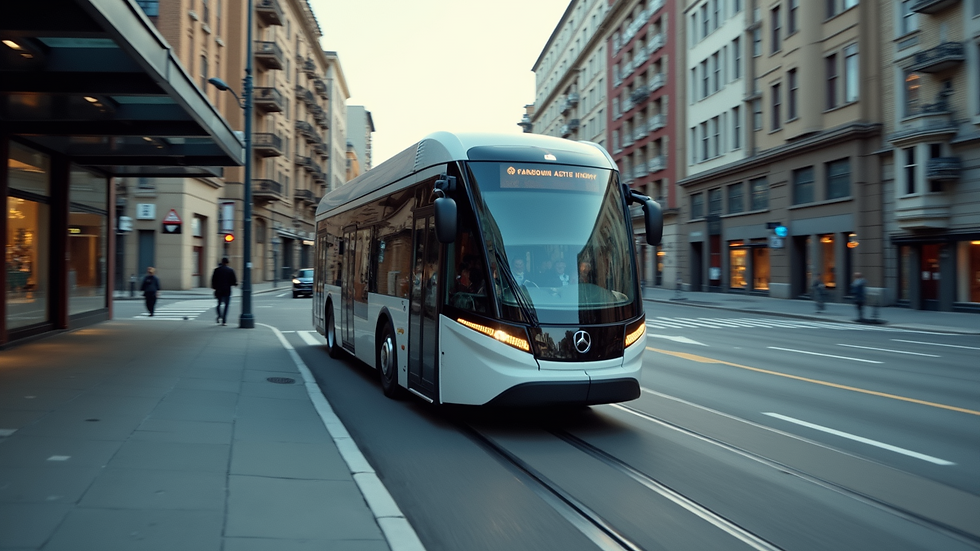Innovations Driving Future Urban Mobility
- Eric Mendez

- 11 minutes ago
- 3 min read
Urban areas worldwide are evolving rapidly, and so are the ways people move within them. As cities grow denser and more complex, traditional transportation methods struggle to keep up. Innovations in technology and design are reshaping how we think about getting from point A to point B. This transformation is essential to create efficient, sustainable, and accessible urban environments.
Exploring Urban Mobility Solutions
Urban mobility solutions are strategies and technologies designed to improve transportation within cities. These solutions aim to reduce congestion, lower emissions, and enhance convenience for commuters. Some of the most promising innovations include:
Electric Vehicles (EVs): Electric cars, bikes, and scooters are becoming more common. They reduce pollution and noise, making cities cleaner and quieter.
Shared Mobility: Car-sharing, bike-sharing, and scooter-sharing programs provide flexible options without the need for ownership.
Smart Traffic Management: Using sensors and AI, cities can optimize traffic flow, reduce wait times, and improve safety.
Public Transit Upgrades: Modernizing buses and trains with cleaner energy and better connectivity encourages more people to use public transport.
These solutions are often combined to create integrated systems that serve diverse urban populations efficiently.

What is meant by future mobility?
Future mobility refers to the next generation of transportation methods and systems that prioritize sustainability, efficiency, and user experience. It encompasses a wide range of technologies and concepts, including autonomous vehicles, connected infrastructure, and alternative fuels.
Key characteristics of future mobility include:
Autonomy: Self-driving cars and buses that reduce human error and improve safety.
Connectivity: Vehicles and infrastructure communicating in real-time to optimize routes and reduce congestion.
Sustainability: Emphasis on renewable energy sources and minimizing environmental impact.
Accessibility: Ensuring transportation options are available to all, including people with disabilities and underserved communities.
By embracing these principles, cities can create transportation networks that are adaptable and resilient.

Cutting-Edge Technologies Shaping Urban Transport
Several technologies are at the forefront of transforming urban mobility:
Autonomous Vehicles (AVs): Self-driving cars and shuttles promise to reduce accidents and free up parking space. Pilot programs are already underway in many cities.
Hyperloop and High-Speed Transit: These systems aim to drastically cut travel times between urban centers.
Mobility-as-a-Service (MaaS): Platforms that integrate various transport modes into a single app, allowing users to plan, book, and pay seamlessly.
Electric Vertical Takeoff and Landing (eVTOL) Aircraft: Urban air mobility solutions that could alleviate ground traffic by offering short-distance flights.
Implementing these technologies requires collaboration between governments, private companies, and communities to address regulatory, safety, and infrastructure challenges.

Benefits of Embracing New Urban Mobility Solutions
Adopting innovative urban mobility solutions offers numerous advantages:
Reduced Traffic Congestion: Smarter traffic management and shared mobility reduce the number of vehicles on the road.
Lower Emissions: Electric and alternative fuel vehicles help cities meet climate goals.
Improved Public Health: Less pollution and more active transport options like biking and walking promote healthier lifestyles.
Economic Growth: Efficient transport attracts businesses and tourism, boosting local economies.
Enhanced Quality of Life: Faster, safer, and more reliable transportation improves daily life for residents.
Cities that invest in these solutions position themselves as leaders in sustainability and innovation.
Steps Toward Implementing Future Urban Mobility
To successfully transition to advanced urban mobility, cities and stakeholders should consider the following steps:
Assess Current Infrastructure: Identify gaps and opportunities for upgrades.
Engage the Community: Gather input to ensure solutions meet diverse needs.
Pilot Innovative Projects: Test new technologies on a small scale before wider rollout.
Develop Policies and Incentives: Encourage adoption of clean and shared transportation.
Invest in Data and Connectivity: Build the digital backbone for smart mobility systems.
Collaborate Across Sectors: Foster partnerships between public agencies, private companies, and academia.
By following these guidelines, urban areas can create adaptable and inclusive transportation networks.
For more insights on future urban mobility, explore resources that highlight emerging trends and best practices.
Looking Ahead: The Future of Urban Transportation
The future of urban transportation is bright and full of potential. As technology advances and cities become more connected, mobility will become more personalized, efficient, and sustainable. Innovations like autonomous vehicles, smart infrastructure, and integrated mobility services will redefine how people live and work in urban spaces.
Embracing these changes requires vision, investment, and collaboration. By prioritizing innovative urban mobility solutions, cities can create environments that are not only easier to navigate but also healthier and more enjoyable for everyone. The journey toward smarter, greener urban transport is underway, and the possibilities are endless.




Comments